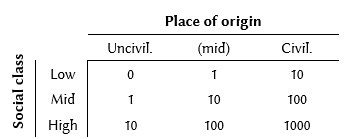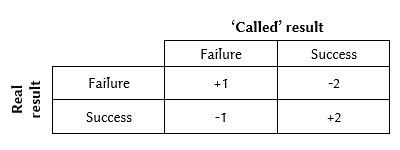HACKSSENTIAL RULES ~ CHAPTER IV
IV. Creation & Progression
IV.1 Character
Every character is defined by a collection of core traits:
Age: Affects Character’s Stats (CS) through modifiers (see IV.2).
Morality: Determines alignment and influences actions and growth.
State of Mind: Used for Reaction checks, represents mental resilience.
Background: Affects part of the ES (see II.4).
Way and Career: Affects the rest of the ES (see II.5).
Derived stats: Calculated from other attributes and include movement (MOV), load, and other status conditions (see V).
IV.2 Creation
Character creation follows a defined sequence. The player makes certain choices and rolls, while the GM handles character’s concealed aspects.
Step 1: Define Core Features
The player begins by selecting key narrative traits:
Morality, Career and Way are freely chosen by the player.
Age is determined by a 1d4 roll:
1 – Younger than 15 years old
2 – 16 to 30 years old
3 – 31 to 45 years old
4 – 46 to 60 years old
Background (i.e., place of origin and social class) is proposed by the player and approved by the GM. It affects Exclusive Skills choice.
Step 2: Determine Character’s Stats (CS)
The GM provides a method for rolling CS values (see II.1). These stats reflect the character’s potential.
Step 3: Apply Age Modifiers to CS
A character’s age affects their base CS values as follows:
Under 15: –1 BU
16–30: +1 BU
31–45: +1 IN, –1 BU
46–60: +1 EM, –1 CO
Each additional 15 years beyond 60: –1 CO and –1 BU
Step 4: Calculate ES Points
The number of starting points available for Exclusive Skills depends on the character’s age and Intellect (IN):
Under 15: IN × 1
16–30: IN × 2
31–45: IN × 3
46–60: IN × 4
Step 5: Allocate ES Points
The total pool of ES points is divided into two parts:
50% must be spent on skills allowed by the character’s chosen Career.
Career-listed skills cost 1 point per rank.Skills outside the Career list cost 2 points per rank.
50% must be allocated based on the character’s Background (place of origin and social class, see II.4), with the GM’s guidance.
There is no constraint for place of origin or social class, the player can choose any ES consistent with both of them (1 point per rank).
Any ES chosen outside the background needs to be pre-approved by the GM based on a sound explanation (2 points per rank).
Step 6: Assets and Equipment
At character creation, starting wealth is derived from two factors: background (place of origin and social class) and career. Each background provides a base amount of resources, measured in days of subsistence. This value is intentionally abstract and setting-agnostic, allowing the GM to define its monetary worth within the context of the game world. In many settings, one day of subsistence may equal roughly two copper coins.
The character’s career then modifies this base value. Some careers apply a multiplier (e.g., ×2, ×5, ×10), while others grant specific items such as a trained mount, tools, or restricted gear (see ‘Assets’ for every career in II.5).
The GM makes the final call on how these resources are represented and what items are available for purchase at character creation.
IV.3 Growth
A PC can improve by:
gaining levels and the measure of his improvement is the Growth, an information not available to the players.
improving in the score of a single ES (see IV.5).
Growth is a value that starts from 0 at every level and it resets once the following level is reached. Growth takes into account:
Actions: the GM can ask the player, before a specific action (deemed to be a relevant situation), to ‘call’ the result of the action:
Targets: predefined by the GM (e.g., the accomplishment of a quest). The GM allocates a reward to a specific accomplishment. The guideline is setting up to 10 points of rewards per PC in a single session.
Impromptu situations are similar to a target but these have not been foreseen by the GM (i.e. a brilliant idea or a superb role-playing): 2 points for a good outcome (i.e. something the GM could expect from that player), 4 points if excellent (i.e. something better than expected), 6 points for an outstanding result (i.e. it will be reminded in the future).
IV.4 Level-up
The character levels up once his Growth reaches the following threshold:
Next level = Actual Level x (20 – Morality Index)
Even if the Morality Index is not a stable value (see II.2), when a level is reached, no later changes in Morality affect the achievement.
The new level grants the PC 2 points to be allocated either in an already known or new ES along the bonus point proper of the career. The allocation ratio is 1:1 for any career’s ES or 2:1 for any other ES.
Any new ES adoption requires time to get the character acquainted with it; the GM rolls a die for the necessary number of weeks as follows:
The GM is asked to add any narrative detail or constraint according to the game setting in order to make the above mechanic consistent within the in-game world. The GM can halve the required weeks from the above table in case the player declares their character is going to only focus on that knowledge along the whole training time. Timing in the above table is assumed as training is one of several character’s activities during downtime.
The character’s level affects how injuries impact on character (see VIII.2).
IV.5 ES improvement
Characters can improve their ES through consistent use in play. This process requires both narrative justification and GM approval.
Whenever a character uses a skill in a meaningful or risky context, the GM may note that usage for potential improvement. After a session, the GM can allow the player to raise the skill by one point, so long as:
The skill was used in situations of narrative consequence.
The skill increase is thematically appropriate to the character’s experiences.
The rule applied by the GM allows an increase in the ES score.
Improvement through use is not guaranteed. The GM is encouraged to be selective and to reward growth that reflects actual play, rather than routine or mechanical repetition.
Additionally, some skills may improve with no downtime while others through formal training, study, or significant downtime. The GM decides when such conditions apply (e.g., a CC requires both training and study) by applying the same criteria of new ES learning (see previous paragraph, i.e., type: simple, average, complex) to ES improvement.
A non-exhaustive list of possible ES improvement rules to be applied:
Number of successes achieved.
Number of successes in a row.
Number of performed checks, regardless of success or failure.
The effective use of an ES which works out a roadblock.
The effective use of an ES which grants an improvement in Morality.
IV.6 Deus Ex-machina
A player may request a Deus Ex-machina intervention by using points from their character’s Morality Index (MI). At every gaming session the player has a number of points equal to their MI to be used for either their own character or other characters:
1 point: Reroll a die and keep the result.
2 points: Roll twice a die and keep the highest result.
3 points: Roll twice a die and keep the lowest result.
If the player uses more points than their MI score in a session, he will not get the expected outcomes from a Deus Ex-machina intervention and permanently lose these points from the character’s MI.
The GM has to handle the in-game application of this rule as if it were a plot twist, like when, in movies, the character is cornered and finds a way.
The GM then also rolls a 1d6: if the result is equal to or less than points spent by the player, further changes to the future events/plot will occur: these changes have delayed effects beyond the immediate benefits gained by the characters; these effects should, in some way, off-set the favor gained by the character in the short term.



